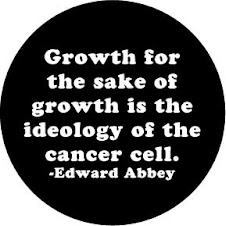Here's the transcript from one segment of this weeks episode from the Living on Earth series from PRI. The interviewer is Steve Curwood.
"CURWOOD: But even if it proves to be economical to capture carbon, controversy still dogs coal.
Campaigners – including actress Darryl Hannah and climate scientist James Hansen - have taken their protests to West Virginia's coal country and gotten arrested – why?
HANSEN: First we believe that no child's health and safety are expendable for the expediency of a dirty energy source.
| |
|
HANNAH: First of all to bring attention to the devastating effects of mountain top removal and to make a call for clean renewable infinite energy resources which we have available to us now.
[SHOUTING]
CURWOOD: At the same time, some West Virginians who depend on coal for their livelihoods hollered at the protesters to go back home.
PRO-COAL PROTESTER: They don't like coal, they need to leave our state...
[CHANTING: "GO BACK HOME, GO BACK HOME"]
CURWOOD: But new research from the University of West Virginia suggests those who live and work in mining areas might want to rethink their allegiance to coal.
Michael Hendryx, a researcher in community medicine at West Virginia University has just published a study finding that coal costs a lot more in human terms than it provides in jobs and income.
HENDRYX: We did an analysis that showed that the areas in Appalachia where coal mining takes place actually have the weakest economic circumstances. They have the highest poverty levels, the highest unemployment levels, the lowest income levels. So we followed up that analysis by trying to come up with an estimate of both the cost and the benefits of mining for the Appalachian region and concluded that the costs outweigh the benefits by several factors.
|
| |
CURWOOD: Professor Hendryx, now as I understand it to calculate this you didn't actually look at the costs they spent on health care or lost opportunities but rather you used something that's known as the value of a statistical life, this particular standard. Tell me about that.
HENDRYX: The way that the value of statistical life or VSL is estimated is through I think a pretty ingenious type of a study design where you ask people, "suppose there was an illness that had a one in 10,000 chance of killing you. How much would you be willing to spend yourself to eliminate that risk?" And let's say that people on average in a given study say $600, which a type of a reasonable or typical estimate that people will give. Then ten thousand people together will spend six million to save one life. So it's a way to estimate what society itself values. And we used a range of those estimates and then looked at the number of excess deaths that occur every year in coal mining areas of Appalachia versus non-mining area.
CURWOOD: 10,000 excess deaths.
HENDRYX: That's right. The years 1997 through 2005, translate to over 10,000 excess deaths every year, and we attribute that difference to higher poverty rates in mining area, and also to differences probably in environmental exposures and pollution from activities in the mining industry.
CURWOOD: And if you translate that into money, how much are you talking about?
HENDRYX: One of the estimates that I think is probably most reasonable to use translates into over $42 billion dollars as the human cost of coal mining in Appalachia. Some of the estimates are as high as over $80 billion dollars.
CURWOOD: And how much in the same period of time was the coal economy itself?
HENDRYX: The benefits of the coal economy measured by not only the direct jobs that it creates but the indirect jobs that ripple through the economy as well as the severance taxes that are paid by coal companies came to a little bit over $8 billion dollars a year, much lower than the estimated costs.
CURWOOD: Can you describe a couple of these communities? Paint a picture for us.
HENDRYX: Well, the first image that comes to mind maybe is a town called Whitesville in Boone County. If you drive through the downtown of Whitesville, you'll see that there will be coal dust on the buildings themselves, on the outdoor furniture, on the vehicles. You'll notice a lot of empty storefronts and empty streets and not a lot of business or economic activity taking place. I don't want to pick on one town, but that's the one that comes to mind. I don't want to pick on the people that live there because they're wonderful.
| |
|
CURWOOD: Now, this isn't a comfortable question to ask, but some would say – look, these communities are very poor, those people might not pay $600 to avoid a one in 10,000 of dying. They don't have any money, they might not pay anything. And the bottom line being, well, human life is maybe worth a lot less in Appalachia in these poor areas.
HENDRYX: Well, I would disagree with that on ethical and moral grounds. But, some people who live there view that their lives are valued less than people who live somewhere else, and that in a way its hard to argue with that. It seems like coal-mining areas in Appalachia are—to us a phrase that's been used "America's Sacrifice Zone" That their lives are expendable so other people somewhere else can have cheap electricity. I find that appalling.
CURWOOD: The federal government's gonna put a lot of money into carbon capture and sequestration from coal fired power plants. How advisable do you think that program is in light of your research?
HENDRYX: I think its one of the dumbest things that they've ever attempted to do. I don't think the evidence is very good that we can implement a scalable carbon capture and storage system that can really be a serious way to deal with CO2 emissions. But even if we could, that addresses only how coal is burned. It doesn't say anything about how it's extracted, processed or transported prior to burning. And carbon capture and storage systems will do nothing to change the conditions in coal mining areas of Appalachia. We have to realize as well that the estimates that come out from the U.S. Geological Survey are that West Virginia will peak in a its coal production in probably less than twenty years. So we really don't have any choice. We can sit around and do nothing and wait for that to happen, or we can begin now to plan and implement serious economic diversification programs. I think that should be a top priority for the state and the nation and even the local community leaders.
CURWOOD: Michael Hendryx is Associate Professor in the Department of Community Medicine at West Virgina University. Thank you so much, Sir.
HENDRYX: Thank you."







.jpg)







No comments:
Post a Comment